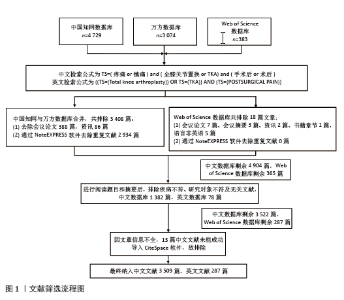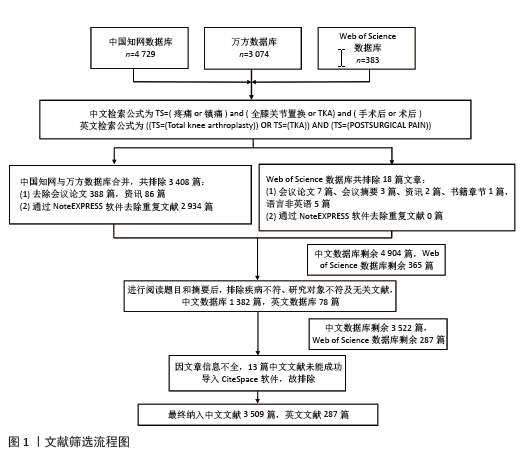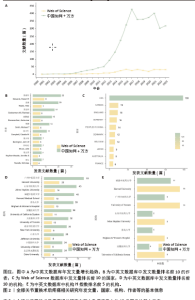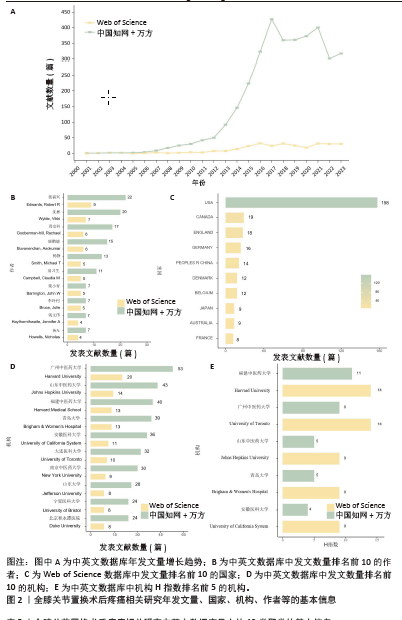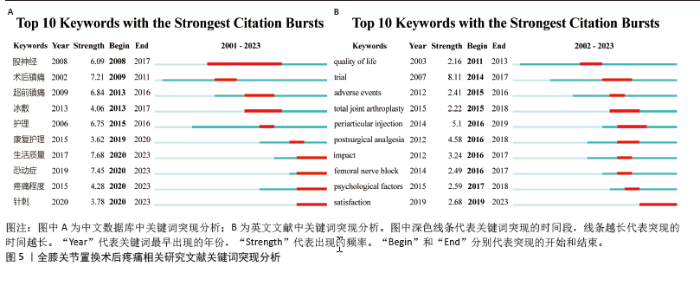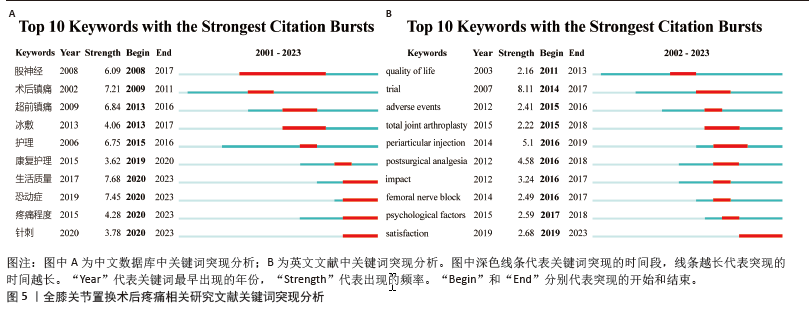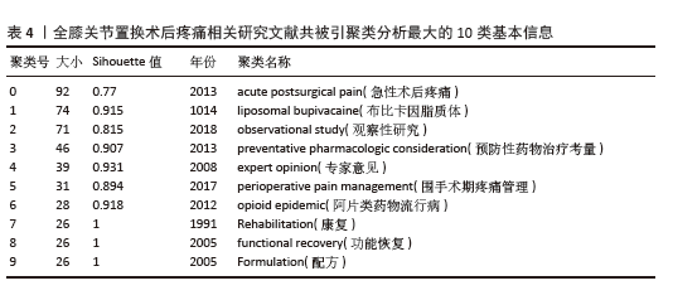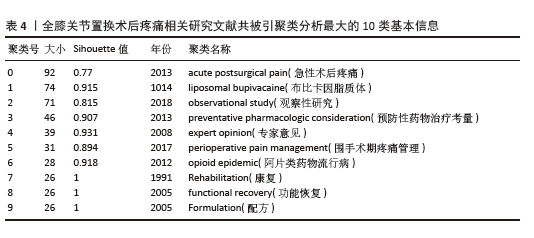Chinese Journal of Tissue Engineering Research ›› 2026, Vol. 30 ›› Issue (3): 795-804.doi: 10.12307/2025.928
Pain after total knee arthroplasty: current status and trend analysis
Zhang Anqi1, Hua Haotian1, Cai Tianyuan1, Wang Zicheng1, Meng Zhuo1, Zhan Xiaoqian1, Chen Guoqian2
- 1Zhejiang Chinese Medical University, Hangzhou 310000, Zhejiang Province, China; 2Department of Orthopedics, Zhejiang Provincial Hospital of Traditional Chinese Medicine, Hangzhou 310000, Zhejiang Province, China
-
Received:2024-09-25Accepted:2024-11-19Online:2026-01-28Published:2025-07-10 -
Contact:Chen Guoqian, MD, Attending physician, Department of Orthopedics, Zhejiang Provincial Hospital of Traditional Chinese Medicine, Hangzhou 310000, Zhejiang Province, China -
About author:Zhang Anqi, Zhejiang Chinese Medical University, Hangzhou 310000, Zhejiang Province, China -
Supported by:Zhejiang Provincial Traditional Chinese Medicine Science and Technology Project, No. 2023ZL369 (to CGQ)
CLC Number:
Cite this article
Zhang Anqi, Hua Haotian, Cai Tianyuan, Wang Zicheng, Meng Zhuo, Zhan Xiaoqian, Chen Guoqian . Pain after total knee arthroplasty: current status and trend analysis[J]. Chinese Journal of Tissue Engineering Research, 2026, 30(3): 795-804.
share this article
Add to citation manager EndNote|Reference Manager|ProCite|BibTeX|RefWorks

2.3 作者合作网络分析 在CiteSpace中,通过制作作者共现图谱可以直观反映研究领域的主要学者群体和科研团队的合作情况。中文文献图谱如图3A所示,节点密度为0.003 5,节点分布不密集;英文文献图谱如图3B所示,密度为0.007 9,节点分布不密集。 在中文文献中,发文量前4的作者裴福兴(22篇)、沈彬(20篇)、周宗科(17篇)和康鹏德(15篇),均隶属四川大学华西医院,该作者群与多个团队交流合作,在髋、膝关节置换术加速康复研究领域较为活跃[5]。在英文文献中,关于膝关节置换术后疼痛领域内发文量第一的作者是来自哈佛大学的Edwards,Robert R (9篇),其发文时间集中于2019-2023年,侧重研究心理与社会因素对与膝关节置换术后疼痛的干预作用[6-7],以及疼痛预测[8-9];发文量第二(7篇)与发文量第三(6篇)的作者分别是布里斯托大学研究者Wylde,Vikki和Gooberman-hill,Rachael,论文发表时间为2011-2022年,二者均侧重研究术后慢性疼痛[10-11],前者最高单篇引用数达444[12],团队内合作关系较为密切,见图2B。 "
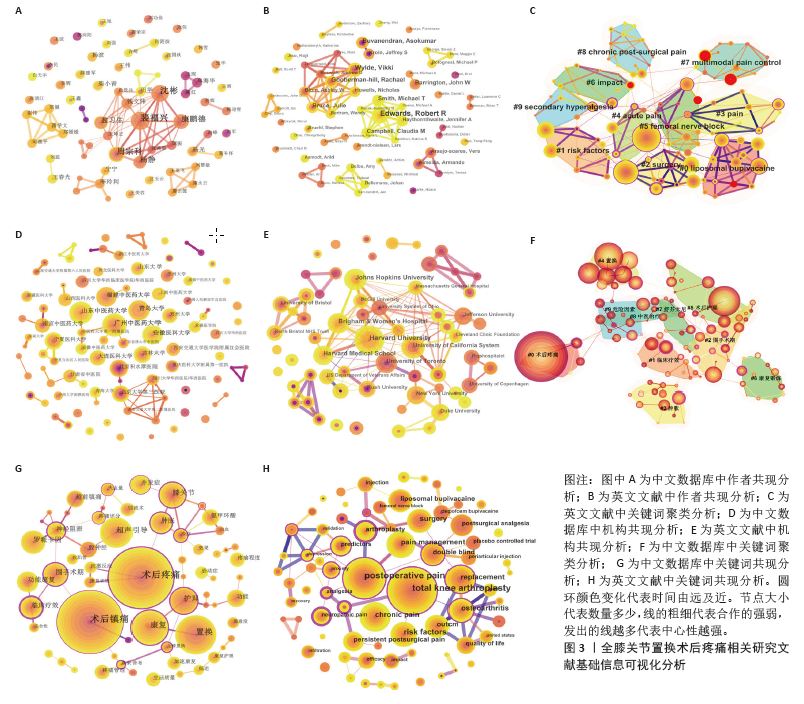
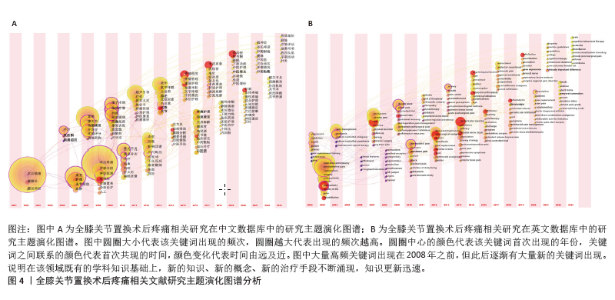
2.4 国家与机构分析 2.4.1 全膝关节置换术后疼痛相关研究的发文国家分析 中文文献都来自中国作者。英文文献的发文量排名前5位的国家分别是美国(158篇)、加拿大(19篇)、英国(18篇)、德国(16篇)和中国(14篇),见图2C。尽管在中文文献中发文数量大,但是在英文文献中美国占总量的54%,而中国只占总量的4.78%。 2.4.2 全膝关节置换术后疼痛相关研究的发文机构分析 H指数(H-index)是一个用于评估科研学术水平与学术影响力的混合量化指标,于2005年由美国物理学家J. E. Hirsch提出,可作为研究机构科研影响力的评价指标。图2D,E和图3D,E示,在中文文献中发文量排名前5的机构分别为广州中医药大学(53篇,H指数:9)、山东中医药大学(43篇,H指数:5)、福建中医药大学(40篇,H指数:11)、青岛大学(39篇,H指数:5)、安徽医科大学 (36篇,H指数:4),排名前5的机构中前三都属于中医药大学,可见中医药大学对全膝关节置换术后疼痛的研究更加深入。在英文文献中,发文量排名前5的机构分别为哈佛大学(23篇,H指数:14)、多伦多大学(17篇,H指数:14)、约翰斯?霍普金斯大学(14篇,H指数:9)、布列根和妇女医院(13篇,H指数:9)、加州大学系统(12篇,H指数:9),其中排名前5的机构均属于美国,中心性排名最高的大学为哈佛大学(0.07)和多伦多大学(0.07)。 2.5 关键词分析 通过对关键词的可视化分析,可以直观感受相关科学领域的研究热点。其中,中文文献共有关键词3 214个,英文文献共有关键词741个,关键词共现分析显示出现频率最高的是“术后镇痛”。在中文文献中出现频次最高的前10个关键词分别为术后镇痛(776次)、术后疼痛(293次)、置换(257次)、康复(164次)、超声引导(152次)、护理(115次)、老年(107次)、膝关节(105次)、罗哌卡因(102次)、肿胀(97次),见图3G。共产生了10个聚类图,聚类分析显示Q值为0.882 6,S值为0.973 3,聚类结构显著,具有较高可信度,排在前5的聚类分别为临床疗效、术后疼痛、冷疗、镇痛和并发症,见图3F和表1。全膝关节置换术后疼痛相关研究主题词演化图谱示,在2008-2023年间出现的新关键词有:超声引导、危险因素、针刺、生活质量等,见图4A。突发关键词是指在一段时间内集中被关注的研究对象,关键词突现分析显示2001-2023年突现的关键词有股神经、术后镇痛、超前镇痛、冰敷和护理,见图5A。 而在英文文献中,据关键词共现分析显示,出现频次最高的前10个关键词分别为全膝置换术(175次)、术后疼痛(132次)、风险因素(65次)、慢性疼痛(61次)、置换(59次)、疼痛管理(58次)、手术(50次)、骨关节炎(48次)、布比卡因(41次)、双盲试验(41次),见图3H。聚类分析显示Q值为0.776 1,S值为0.905 9,排在前5的聚类分别为脂质体布比卡因、风险因素、手术、疼痛和急性疼痛,见图3C和表2。全膝关节置换术后疼痛相关研究主题词演化图谱示,在2008-2023年间出现的新关键词有:神经病理性疼痛、危险因素、膝关节注射、心理影响等,见图4B。关键词突现分析显示2002-2023年突现的关键词有生活质量、实验、副反应、全膝关节置换和关节周围注射,见图5B。"
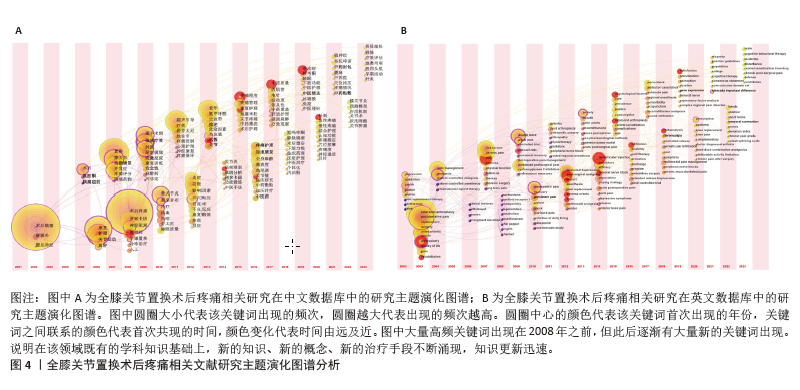
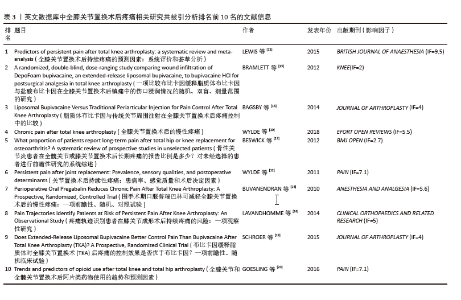
2.6 英文数据库文献共被引分析 2000-2023年,该领域发表的论文共参考了9 674篇文献,排名前10位的共被引文献见表3。其中LEWIS等[13]发表的《全膝关节置换术后持续疼痛的预测因素:系统评价和荟萃分析》被引次数最高,达27次,其认为灾难化、心理健康、术前膝关节疼痛和其他部位疼痛是全膝关节置换术后持续疼痛最强的独立预测因素,并通过实施单变量和多变量统计模型的研究结果进行了单独的荟萃分析,确定每个预测因子对持续性疼痛的影响大小。BUVANENDRAN 等[14]进行的一项前瞻性研究,发现围术期服用普瑞巴林可降低全膝关节置换术后慢性神经性疼痛的发生率,以期降低术后对阿片类药物的消耗。文献共被引聚类分析得出排名前10位的聚类依次为急性术后疼痛、脂质体布比卡因、观察性研究、预防性药物考虑、专家意见、围术期疼痛管理、阿片类药物流行、康复、功能恢复、制剂,聚类图谱的S=0.854 6,Q=0.801 1,可信度高,见表4。"
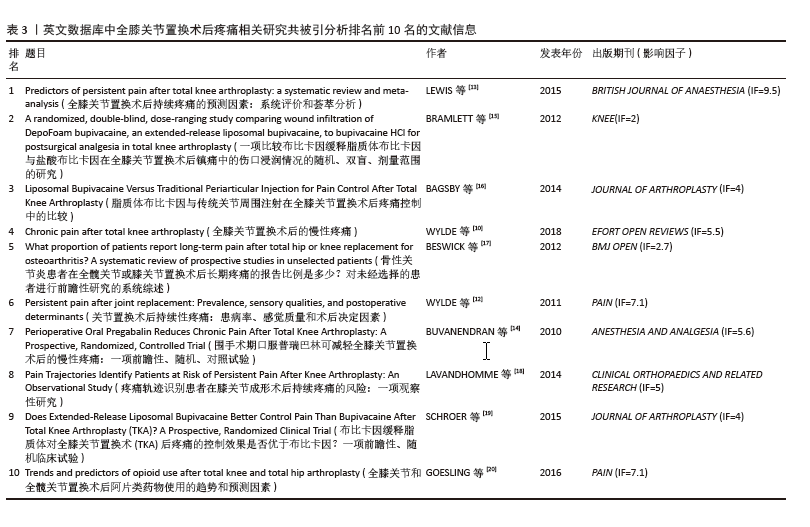
| [1] 王红,丁勇,田娟.早期康复训练对人工全髋关节置换术后康复诸因素的影响[J].中国临床康复,2003,7(8):1326. [2] CHOU R, GORDON DB, DE LEON-CASASOLA OA, et al. Management of Postoperative Pain: A Clinical Practice Guideline From the American Pain Society, the American Society of Regional Anesthesia and Pain Medicine, and the American Society of Anesthesiologists’ Committee on Regional Anesthesia, Executive Committee, and Administrative Council. J Pain. 2016;17(2):131-157. [3] HADLANDSMYTH K, ZIMMERMAN MB, WAJID R, et al. Longitudinal Postoperative Course of Pain and Dysfunction Following Total Knee Arthroplasty. Clin J Pain. 2018; 34(4):332-338. [4] WU T, HUANG W, QI J, et al. Research trends and frontiers on antiphospholipid syndrome: A 10-year bibliometric analysis (2012-2021). Front Pharmacol. 2022;13:1035229. [5] 周宗科,翁习生,向兵,等.中国髋、膝关节置换术加速康复:围术期贫血诊治专家共识[J].中华骨与关节外科杂志, 2016,9(1):10-15. [6] ABRECHT CR, CORNELIUS M, WU A, et al. Prediction of Pain and Opioid Utilization in the Perioperative Period in Patients Undergoing Primary Knee Arthroplasty: Psychophysical and Psychosocial Factors. Pain Med. 2019;20(1):161-171. [7] NANDI M, SCHREIBER KL, MARTEL MO, et al. Sex differences in negative affect and postoperative pain in patients undergoing total knee arthroplasty. Biol Sex Differ. 2019;10(1):23. [8] OWENS MA, MUN CJ, HAMILTON KR, et al. Presurgical sleep and pain behaviors predict insomnia symptoms and pain after total knee arthroplasty: a 12-month longitudinal, observational study. Pain Med. 2023;24(11):1224-1233. [9] HAMILTON KR, HUGHES AJ, CAMPBELL CM, et al. Perioperative insomnia trajectories and functional outcomes after total knee arthroplasty. Pain. 2023;164(12):2769-2779. [10] WYLDE V, BESWICK A, BRUCE J, et al. Chronic pain after total knee arthroplasty. EFORT Open Rev. 2018;3(8):461-470. [11] WYLDE V, BERTRAM W, BESWICK AD, et al. Clinical- and cost-effectiveness of the STAR care pathway compared to usual care for patients with chronic pain after total knee replacement: study protocol for a UK randomised controlled trial. Trials. 2018;19(1):132. [12] WYLDE V, HEWLETT S, LEARMONTH ID, et al. Persistent pain after joint replacement: Prevalence, sensory qualities, and postoperative determinants. Pain. 2011;152(3):566-572. [13] LEWIS GN, RICE DA, MCNAIR PJ, et al. Predictors of persistent pain after total knee arthroplasty: a systematic review and meta-analysis. Br J Anaesth. 2015;114(4):551-561. [14] BUVANENDRAN A, KROIN JS, DELLA VALLE CJ, et al. Perioperative Oral Pregabalin Reduces Chronic Pain After Total Knee Arthroplasty: A Prospective, Randomized, Controlled Trial. Anesth Analg. 2010;110(1):199-207. [15] BRAMLETT K, ONEL E, VISCUSI ER, et al. A randomized, double-blind, dose-ranging study comparing wound infiltration of DepoFoam bupivacaine, an extended-release liposomal bupivacaine, to bupivacaine HCl for postsurgical analgesia in total knee arthroplasty. Knee. 2012;19(5):530-536. [16] BAGSBY DT, IRELAND PH, MENEGHINI RM. Liposomal Bupivacaine Versus Traditional Periarticular Injection for Pain Control After Total Knee Arthroplasty. J Arthroplasty. 2014;29(8):1687-1690. [17] BESWICK AD, WYLDE V, GOOBERMAN-HILL R, et al. What proportion of patients report long-term pain after total hip or knee replacement for osteoarthritis? A systematic review of prospective studies in unselected patients. BMJ Open. 2012;2(1):e000435. [18] LAVAND’HOMME PM, GROSU I, FRANCE MN, et al. Pain Trajectories Identify Patients at Risk of Persistent Pain After Knee Arthroplasty: An Observational Study. Clin Orthop Relat Res. 2014;472(5):1409-1415. [19] SCHROER WC, DIESFELD PG, LEMARR AR, et al. Does Extended-Release Liposomal Bupivacaine Better Control Pain Than Bupivacaine After Total Knee Arthroplasty (TKA)? A Prospective, Randomized Clinical Trial. J Arthroplasty. 2015;30(9):64-67. [20] GOESLING J, MOSER SE, ZAIDI B, et al. Trends and predictors of opioid use after total knee and total hip arthroplasty. Pain. 2016;157(6):1259-1265. [21] ZHANG Z, SONG K, YAO Y, et al. Incidence and Risk Factors for Post-Thrombotic Syndrome in Patients With Deep Vein Thrombosis Following Total Knee and Hip Arthroplasty. J Arthroplasty. 2019;34(3): 560-563. [22] LI JW, MA YS, XIAO LK. Postoperative Pain Management in Total Knee Arthroplasty. Orthop Surg. 2019;11(5):755-761. [23] 王宁,罗汉民.超前镇痛护理模式在膝关节置换术患者围手术期的应用[J].中国当代医药,2023,30(18):170-173. [24] 赖迎秋.膝关节置换术患者实施疼痛评估及护理干预对其术后活动能力的影响研究[J].中国社区医师,2019,35(35): 137+139. [25] 王伟,姜晨轶,丁小萍.改良疼痛评估方法在全膝关节置换术后病人中的应用[J].护理研究,2017,31(11):1402-1403. [26] 姜俪凡,冯艺,安海燕.人工全膝关节置换术康复锻炼期镇痛方式对关节功能恢复的影响[J].中国疼痛医学杂志,2014, 20(2):90-94. [27] 王旭,高玉华,郭斌,等.罗哌卡因复合舒芬太尼或地佐辛连续股神经阻滞在全膝关节置换术后镇痛中的应用[J].临床麻醉学杂志,2016,32(3):258-261. [28] 崔翔.不同浓度罗哌卡因收肌管阻滞结合股外侧皮神经阻滞用于全膝关节置换术后的镇痛效果研究[D].太原:山西医科大学,2023. [29] 吴明珑,田薇,刘洪娟.人工全膝关节置换术后最佳冰敷时间及频率的研究[J].骨科,2015,6(3):159-161. [30] 蔡立柏,刘延锦,李英,等.多学科协作干预方案在全膝关节置换术后恐动症患者中的应用研究[J].中华护理杂志, 2020,55(4):494-499. [31] 王博,老年全膝关节置换术患者恐动症状况及其与心理韧性、家庭关怀的关系研究[D].济南:山东中医药大学,2020. [32] 赵传伟.耳穴压豆联合穴位贴敷改善全膝关节置换术后疼痛的临床研究[D].北京:中国中医科学院,2022. [33] 杨勇,尹吉恒,韩丽.TKA术后患肢穴位电针刺治疗对术后疼痛及康复的影响[J].世界最新医学信息文摘,2017,17(35): 24-25+27. [34] 北京医学会骨科专业委员会关节外科学组,中华医学会骨科学分会关节外科学组.中国全膝关节置换术围手术期疼痛管理指南(2022)[J].协和医学杂志,2022, 13(6):965-985. [35] ASO K, IKEUCHI M, TAKAYA S, et al. Chronic postsurgical pain after total knee arthroplasty: A prospective cohort study in Japanese population. Mod Rheumatol. 2021;31(5):1038-1044. [36] GROSU I, LAVAND’HOMME P, THIENPONT E. Pain after knee arthroplasty: an unresolved issue. Knee Surg Sports Traumatol Arthrosc. 2014;22(8):1744-1758. [37] RAJA SN, CARR DB, COHEN M, et al. The revised International Association for the Study of Pain definition of pain: concepts, challenges, and compromises. Pain. 2020; 161(9):1976-1982. [38] HAH JM, CRAMER E, HILMOE H, et al. Factors Associated With Acute Pain Estimation, Postoperative Pain Resolution, Opioid Cessation, and Recovery Secondary Analysis of a Randomized Clinical Trial. JAMA Netw Open. 2019;2(3):e190168. [39] SPRINGBORG AH, KEHLET H, NIELSEN NI, et al. Predictors of subacute postoperative pain after total knee arthroplasty: A secondary analysis of two randomized trials. Eur J Pain. 2025;29(1):e4703. [40] BURNS LC, RITVO SE, FERGUSON MK, et al. Pain catastrophizing as a risk factor for chronic pain after total knee arthroplasty: a systematic review. J Pain Res. 2015;8: 21-32. [41] SCHWARZKOPF R, DREXLER M, MA MW, et al. Is There a Benefit for Liposomal Bupivacaine Compared to a Traditional Periarticular Injection in Total Knee Arthroplasty Patients With a History of Chronic Opioid Use? J Arthroplasty. 2016; 31(8):1702-1705. [42] WHALE K, WYLDE V, BESWICK A, et al. Effectiveness and reporting standards of psychological interventions for improving short-term and long-term pain outcomes after total knee replacement: a systematic review. BMJ Open. 2019;9(12):e029742. [43] KRAEKEL SM, CABARCAS BC, SALOMON KI, et al. Impact of State Opioid Regulation on Postoperative Opioid Prescribing Patterns for Total Knee Arthroplasty: A Retrospective Analysis. J Am Acad Orthop Surg. 2023;31(5):258-264. [44] ABDALLAH FW, GILRON I, FILLINGIM RB, et al. AAAPT Diagnostic Criteria for Acute Knee Arthroplasty Pain. Pain Med. 2020;21(5):1049-1060. [45] SPRINGBORG AH, VISBY L, KEHLET H, et al. Psychological predictors of acute postoperative pain after total knee and hip arthroplasty: A systematic review. Acta Anaesthesiol Scand. 2023;67(10): 1322-1337. [46] GOLLADAY GJ, BALCH KR, DALURY DF, et al. Oral Multimodal Analgesia for Total Joint Arthroplasty. J Arthroplasty. 2017; 32(9):S69-S73. [47] MEMTSOUDIS SG, POERAN J, ZUBIZARRETA N, et al. Association of Multimodal Pain Management Strategies with Perioperative Outcomes and Resource Utilization A Population-based Study. Anesthesiology. 2018;128(5):891-902. [48] SUN H, HUANG ZY, ZHANG ZQ, et al. A Meta-Analysis Comparing Liposomal Bupivacaine and Traditional Periarticular Injection for Pain Control after Total Knee Arthroplasty. J Knee Surg. 2019;32(3):251-258. [49] JIANG H, MA Q, DONG J, et al. The effect of liposomal bupivacaine for surgical wound infiltration: A meta-analysis of randomised controlled trials. Int Wound J. 2023;20(5):1591-1608. [50] LIU Y, ZENG Y, ZENG JF, et al. The efficacy of liposomal bupivacaine compared with traditional peri-articular injection for pain control following total knee arthroplasty: an updated meta-analysis of randomized controlled trials. BMC Musculoskelet Disord. 2019;20(1):306. [51] 马国续.收肌管阻滞与股神经阻滞在全膝关节置换快速康复中的临床疗效分析[D].银川:宁夏医科大学,2019. [52] 李潞,汪文静,王海丽. 超声引导下收肌管阻滞联合坐骨神经阻滞在膝关节置换术后的镇痛效果[J].海军医学杂志, 2022,43(5):505-508. [53] 刘羡,周琴,李仁华.腘丛神经阻滞对全膝关节置换术患者术后镇痛、应激反应及功能恢复的影响[J].医学理论与实践, 2023,36(24):4206-4209. [54] SUN EC, BATEMAN BT, MEMTSOUDIS SG, et al. Lack of Association Between the Use of Nerve Blockade and the Risk of Postoperative Chronic Opioid Use Among Patients Undergoing Total Knee Arthroplasty: Evidence From the Marketscan Database. Anesth Analg. 2017;125(3):999-1007. [55] SWISHER MW, BALL ST, GONZALES FB, et al. A Randomized Controlled Pilot Study Using Ultrasound-Guided Percutaneous Cryoneurolysis of the Infrapatellar Branch of the Saphenous Nerve for Analgesia Following Total Knee Arthroplasty. Pain Ther. 2022;11(4):1299-1307. [56] 白天宇.经皮穴位电刺激联合多模式镇痛改善TKA术后疼痛加速康复的临床研究[D].北京:中国中医科学院,2023. [57] 钟伟华,苟凌云,廖明军,等.耳穴压丸法辅助镇痛对原发性全膝关节置换术后下肢疼痛和膝关节功能的影响[J].亚太传统医药,2023,19(3):88-93. [58] 张坤鹏,陈先进.血府逐瘀汤在全膝关节置换术后肿痛治疗中的应用效果[J].中国社区医师,2023,39(1):63-65. [59] 李凯明,金添,申杨勇,等.经皮穴位电刺激对膝关节置换患者生存质量中远期疗效评价[J].辽宁中医药大学学报,2023, 25(10):59-63. |
| [1] | Xu Canli, He Wenxing, Wang Yuping, Ba Yinying, Chi Li, Wang Wenjuan, Wang Jiajia. Research context and trend of TBK1 in autoimmunity, signaling pathways, gene expression, tumor prevention and treatment [J]. Chinese Journal of Tissue Engineering Research, 2026, 30(在线): 1-11. |
| [2] | Yang Zeyu, Zhi Liang, Wang Jia, Zhang Jingyi, Zhang Qingfang, Wang Yulong, Long Jianjun. A visualized analysis of research hotspots in high-frequency repetitive transcranial magnetic stimulation from the macroscopic perspective [J]. Chinese Journal of Tissue Engineering Research, 2026, 30(5): 1320-1330. |
| [3] | Peng Hao, Chen Qigang, Shen Zhen. A visual analysis of research hotspots of H-type vessels in various bone diseases [J]. Chinese Journal of Tissue Engineering Research, 2026, 30(3): 760-769. |
| [4] | Jiang Kan, Alimujiang·Abudourousuli, Shalayiding·Aierxiding, Aikebaierjiang·Aisaiti, Kutiluke·Shoukeer, Aikeremujiang·Muheremu. Biomaterials and bone regeneration: research hotspots and analysis of 500 influential papers [J]. Chinese Journal of Tissue Engineering Research, 2026, 30(2): 528-536. |
| [5] | Zhao Qianwei, Sun Guangyuan . Intestinal organoids: a bibliometric analysis of the latest trends in tissue/organ biology, disease modeling, and clinical applications [J]. Chinese Journal of Tissue Engineering Research, 2026, 30(1): 238-247. |
| [6] | Liang Haobo, Wang Zeyu, Ma Wenlong, Liu Hao, Liu Youwen. Hot issues in the field of joint revision: infection, rehabilitation nursing, bone defect, and prosthesis loosening [J]. Chinese Journal of Tissue Engineering Research, 2025, 29(9): 1963-1971. |
| [7] | Zhou Jinhai, Li Jiangwei, Wang Xuquan, Zhuang Ying, Zhao Ying, Yang Yuyong, Wang Jiajia, Yang Yang, Zhou Shilian. Three-dimensional finite element analysis of anterior femoral notching during total knee arthroplasty at different bone strengths [J]. Chinese Journal of Tissue Engineering Research, 2025, 29(9): 1775-1782. |
| [8] | Lyu Liting, Yu Xia, Zhang Jinmei, Gao Qiaojing, Liu Renfan, Li Meng, Wang Lu. Bibliometric analysis of research process and current situation of brain aging and exosomes [J]. Chinese Journal of Tissue Engineering Research, 2025, 29(7): 1457-1465. |
| [9] | Chang Jinxia, Liu Yufei, Niu Shaohui, Wang Chang, Cao Jianchun. Visualization analysis of macrophage polarization in tissue repair process [J]. Chinese Journal of Tissue Engineering Research, 2025, 29(7): 1486-1496. |
| [10] | Li Huijun, Li Huangyan, Zhang Yeting. Physical activity and cognition in older adults: research hotspot and topic evolution [J]. Chinese Journal of Tissue Engineering Research, 2025, 29(5): 1073-1080. |
| [11] | Dang Xiaowen, Huang Hailiang, Huang Lei, Wang Yajie . Research frontiers and hotspots of carbon nanomaterials in biomedical field over the past 10 years [J]. Chinese Journal of Tissue Engineering Research, 2025, 29(4): 752-760. |
| [12] | Ma Yucong, Ouyang Zhengzheng, Liu Xiaojie, Yang Sifei. Tracking of research trends and hotspots in medical magnesium alloy materials [J]. Chinese Journal of Tissue Engineering Research, 2025, 29(34): 7470-7480. |
| [13] | Guo Haizhen, Cong Zidong, Zhao Yuke, Li Xiaofeng, Yu Lu, Qian Shule, Wang Runying, Du Wuxun. Development of patch clamp technology in the past 10 years: visual analysis based on CiteSpace and VOSviewer [J]. Chinese Journal of Tissue Engineering Research, 2025, 29(31): 6717-6726. |
| [14] | Zheng Xiaodong, Gao Shan, Han Wenjin, Liu Lijun, Jia Menglong, Yu Longtan. Visual analysis of treatment of adolescent idiopathic scoliosis [J]. Chinese Journal of Tissue Engineering Research, 2025, 29(3): 645-653. |
| [15] | Xu Qiang, Qin Jialin, Lian Zeshuang, Wang Aoting, Li Ding, Wang Ye, Wang Junfang. Visual analysis of hot spots and trends in the study of ligamentum flavum ossification [J]. Chinese Journal of Tissue Engineering Research, 2025, 29(3): 628-636. |
| Viewed | ||||||
|
Full text |
|
|||||
|
Abstract |
|
|||||
